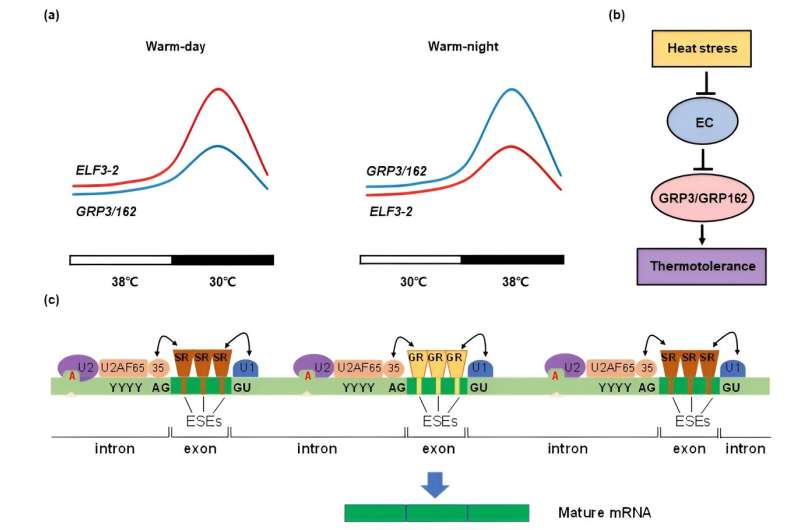This article has been reviewed according to Science X's editorial process and policies. Editors have highlighted the following attributes while ensuring the content's credibility:
fact-checked
trusted source
proofread
Protecting rice plants from heat when it attacks at nighttime

Rice (Oryza sativa L.) is the staple food for more than half of the world's population. Based on mathematical modeling, worldwide cereal production is estimated to have a loss of 6%–7% yield per 1°C increase in seasonal mean temperature associated with extreme heat disasters.
In the past century, the daily minimum temperature in nighttime increased more than the daily maximum temperature in daytime. Crops, such as rice, have different sensitivity to heat stress between day and night and among different varieties. However, how this diurnal difference in thermotolerance is acquired in plants remains elusive.
The circadian clock is a ubiquitous controlling system that allows plants to coordinate their growth and development with day and night signals, however, factors that provide temporal resistance in a diurnal manner await discovery.
Chuang Yang and a team from Zhejiang University found two rice glycine-rich proteins with RNA recognition motifs, OsGRP3 and OsGRP162, are rhythmically expressed and heat-induced at night time, and such rhythmical induction by heat stress at midnight is largely dependent on OsELF3-2, one of the EC components.
The study, led by Prof. Jian-Xiang Liu (State Key Laboratory of Plant Environmental Resilience, College of Life Sciences, Zhejiang University), is published in the journal Science Bulletin.
To examine whether EC can repress the promoter activity of OsGRP3/OsGRP162, the team carried out effector-reporter assays. The results support that the diurnal induction of OsGRP3/OsGRP162 by heat stress is due to the diurnal reduction of EC activity under high temperature conditions.
To explore the biological function of OsGRP3/OsGRP162 in heat-stress tolerance in rice, the team generated several alleles of gene-edited double mutants of OsGRP3/OsGRP162 and carried out phenotypic assays at both seedling and reproductive stages.
The survival rates and seed setting rates of the double mutants were much reduced compared to that of wild-type control plants after heat stress treatment. These results support that OsGRP3 and OsGRP162 are required for heat stress tolerance in rice.
Subsequently, the team checked thermotolerance in the wild-type and the double mutant of OsGRP3/OsGRP162 at reproductive stage when heat stress occurred between daytime and nighttime.
The results showed that the seed setting rate and grain weight of the double mutants were more reduced by heat stress when heat stress occurred at night time than the at daytime. Thus, OsGRP3/OsGRP162 are involved in the diurnal regulation of thermotolerance in rice.
To further investigate the mechanism of thermotolerance conferred by OsGRP3/OsGRP162, the team carried out RNA-seq analysis. Upon heat stress, the double mutant of OsGRP3/OsGRP162 displayed globally reduced expression of heat-stress responsive genes and increased mRNA alternative splicing dominated by exon-skipping.
Multiple experimental results demonstrated that OsGRP3/OsGRP162 directly bind to target mRNAs and participate in alternative splicing through interacting with the U1/U2 spliceosomal factors.
In all, the team demonstrated the important role of OsGRP3/OsGRP162 in rice heat tolerance and revealed that OsGRP3/OsGRP162 regulate thermotolerance through controlling mRNA alternative splicing in a diurnal manner.
Since plant growth and yield production are constantly subjected to environmental stresses day and night under natural conditions, this study sheds light on how circadian clock regulates diurnal thermotolerance in plants.
More information: Chuang Yang et al, Diurnal regulation of alternative splicing associated with thermotolerance in rice by two glycine-rich RNA-binding proteins, Science Bulletin (2023). DOI: 10.1016/j.scib.2023.11.046
Provided by Science China Press





















